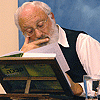Different Languages Describe The Same Spiritual Reality
 The Zohar, Chapter “VeYechi (And Jacob Lived),” Item 451: On the third watch, the Cherubim strike their wings and sing, as it is written, “Praise the Lord! Praise, O servants of the Lord, praise the name of the Lord. Blessed be the name of the Lord … from the rising of the sun to its setting.” Then all the angels that stand on the third watch sing.
The Zohar, Chapter “VeYechi (And Jacob Lived),” Item 451: On the third watch, the Cherubim strike their wings and sing, as it is written, “Praise the Lord! Praise, O servants of the Lord, praise the name of the Lord. Blessed be the name of the Lord … from the rising of the sun to its setting.” Then all the angels that stand on the third watch sing.
In The Study of the Ten Sefirot, we can study the spiritual actions by way of the three lines, the Lights, the Kelim (vessels), the screens, and the Reshimot (spiritual genes, reminiscences). However, The Zohar describes the same actions through the holy still, vegetative, and animate objects which are the forces in one’s work. In other words, the various parts of the soul are named after the various types of the still, vegetative, and animate objects of nature and man.
It is difficult for us to conceive of them as terms in spiritual physics, like those in TES. In the ARI’s The Tree of Life, we see how hard it is to depict the variability of spiritual actions in the language of Sefirot and Partzufim.
For this reason, there is another language in the spiritual world: the language of branches. Here, we take a particular branch of the spiritual world in this world, where each branch has its own particular name. Thus, in every case, even the smallest spiritual detail has a particular name intended specifically for this spiritual quality or action. We use these names and end up with a language that is more simple and precise.
If we were to rewrite in the language of Kabbalah all that Moses had written in the Torah, we would end up with a voluminous book. However, using the language of branches, everything is expressed very concisely. A person who senses spiritual reality has a much easier time perceiving the text which describes the Upper World with corporeal names. After all, the two worlds are parallel, and he who senses the Upper World sees their correspondence.
The other advantage of the language of branches is that the same names are applicable in all the worlds and degrees for every branch corresponds precisely to its root. Therefore, as we read The Zohar with the Sulam Commentary which combines the language of Kabbalah that clarifies the picture from this world described in the language of branches, we begin to see that Rabbi Shimon bar Yochai, the ARI, and Baal HaSulam all write about exactly the same thing.
[22119]
From the 2nd part of the Daily Kabbalah Lesson 9/28/10, The Zohar
Related Material:
Laitman.com Post: Attaining The Names Of The Creator
Laitman.com post: The Common Language Between Us And The Creator
Laitman.com Post:The Zohar Speaks In The Language Of Branches







Discussion | Share Feedback | Ask a question